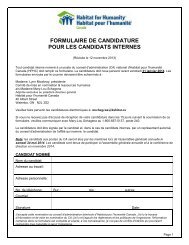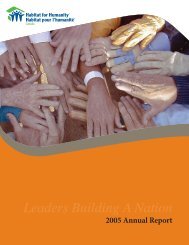PROGRESS IN HAITI
PROGRESS IN HAITI - Habitat for Humanity Canada
PROGRESS IN HAITI - Habitat for Humanity Canada
Create successful ePaper yourself
Turn your PDF publications into a flip-book with our unique Google optimized e-Paper software.
SIX-MONTH REPORT<br />
<strong>PROGRESS</strong> <strong>IN</strong> <strong>HAITI</strong><br />
Rebuild Haiti<br />
Rebati Ayiti
REAL NEED…<br />
Six months after a magnitude-7.0 earthquake destroyed<br />
nearly 190,000 homes and left more than 1.5 million<br />
survivors in need of shelter, the need in Haiti is great and<br />
undeniable. Haitian hearts still mourn for family, friends,<br />
homes and jobs lost on Jan. 12.<br />
The scale of cleanup and rubble removal remains<br />
daunting. Displaced families crowd into urban tent cities,<br />
survive in their own makeshift shelters, or seek refuge<br />
in other parts of the country. And now the summer rainy<br />
season has begun, highlighting almost daily the urgent<br />
need for safe, healthy shelter.<br />
REAL FAMILIES…<br />
At the same time, life goes on. The resilience of Haiti’s<br />
people is evident everywhere. Businesses reopen in front<br />
of collapsed buildings. Families work to clear rubble where<br />
their homes once stood, and worship on Sunday inside<br />
churches still missing front doors.<br />
Many families are partnering with Habitat for Humanity<br />
to provide safe, healthy housing for themselves and their<br />
children. Please meet:<br />
• ROSE FLORE CHARLES AND HER THREE CHILDREN, who now<br />
live in a Habitat transitional shelter. “This is not just a<br />
transitional shelter for me,” Charles says. “It is a home.”<br />
(See next page)<br />
• GRANDMOTHER ANOLISE SIMON, who can continue to look<br />
after her flock of relatives in a new Habitat core house.<br />
(See page 5)<br />
• ELYCÉ MÉDILIEN, who received construction training from<br />
Habitat so he can help rebuild his hometown. (See page 6)<br />
REAL<br />
<strong>PROGRESS</strong>…<br />
Over the next five years, Habitat<br />
aims to serve 50,000 earthquakeaffected<br />
families, helping Haitians<br />
move toward safer, more secure,<br />
permanent places to call home.<br />
Just six months after the earthquake, Habitat is:<br />
• Constructing about 70 transitional shelters a<br />
week—in places like Cabaret, below—providing<br />
safe, dry housing for Haitians living in unhealthy,<br />
vulnerable conditions.<br />
• Working through Habitat Resource Centers to train<br />
and employ local workers in building efforts—<br />
and supplying families with courses in disaster<br />
mitigation and financial literacy.<br />
• Providing more than 21,000 emergency shelter<br />
kits, conducting structural damage assessments in<br />
affected houses, repairing homes, and advocating<br />
for land-tenure policies to protect families’ property<br />
rights as they rebuild.<br />
Read on to learn about the strength of Haiti’s<br />
families—and how you can help Habitat help Haiti.
Top: After the earthquake, the Charles family<br />
lived in an unhealthy makeshift structure.<br />
Bottom: Today, the Charles family lives in a<br />
new Habitat transitional shelter.<br />
THE CHARLES FAMILY:<br />
Thirsting for a house<br />
Rose Flore Charles and her three young children spent Jan.<br />
12, 2010, at the Léogâne home of Charles’ mother. They<br />
were not in their small apartment across town at 4:53 p.m.<br />
when the building collapsed during the earthquake, killing<br />
three of their neighbors. In that minute, nearly 90 percent<br />
of Léogâne was destroyed.<br />
For 16 straight nights, Charles and her children slept<br />
outside. Charles soon created a makeshift shelter near<br />
her mother’s damaged home. Made mostly of bedsheets,<br />
with metal gates propped together to provide a façade of<br />
strength, the structure has only a green coat-hanger wire to<br />
hold a scrap door tight.<br />
In Haiti’s rainy season—which brings even more malariacarrying<br />
mosquitoes—Charles’ children suffered. “Sleeping<br />
in the old shelter, the rain always got in,” Charles says. “We<br />
have to go to the health center and ask for help when their<br />
fevers get very bad.”<br />
As she speaks, a light rain leaves beads of water on her<br />
shoulders and on her 2-year-old daughter, Guallina Delva. But<br />
soon the Charles family will have a new place to take refuge:<br />
a Habitat transitional shelter.<br />
“I am thirsting for this house,” Charles says, smiling as<br />
she watches the wood-frame shelter being built.<br />
Charles’ family received one of the first 25 Habitat<br />
transitional shelters built in this community within Léogâne,<br />
about 18 miles west of Port-au-Prince and very near the<br />
epicenter of the January earthquake. By training and<br />
employing Haitians in communities hit hardest by the<br />
earthquake, Habitat is now constructing about 70 transitional<br />
shelters a week. Families help, too; Charles helped clear the<br />
ground for her shelter and hammered in nails.<br />
“This is not just a transitional<br />
shelter for me. It is a home.”
THE JOSEPH FAMILY: Return to living<br />
Today, Sainte Hélen Joseph’s family feels a security they<br />
hadn’t felt in the past six months. Their new Habitat<br />
transitional shelter stands among a row of six built in<br />
Cabaret’s Bercy community, just north of Port-au-Prince.<br />
A feeling of renewal has formed among families who lost<br />
everything in the earthquake. Joseph and her husband are<br />
farming once again, growing plantains and eggplants as<br />
they save to rebuild a permanent home.<br />
From her new Habitat shelter, Joseph, 28, can see the<br />
makeshift structure that she, her husband and their four<br />
children—including Derlince, at left—called home for four<br />
months. Used cloth, bedsheets and bags formed walls<br />
that came nowhere near the ground, leaving the family<br />
vulnerable to many types of intruders.<br />
“We really needed this. To me,<br />
compared to what we were<br />
living in, this is a house. Our old<br />
shelter—that wasn’t living.”<br />
THE BLANC FAMILY: Safe at home<br />
Voltaire Blanc had traveled to Gonaïves, further north in<br />
Haiti, to be with a brother undergoing surgery on Jan. 12. A<br />
motorcycle-taxi driver, he had no idea of the severity of the<br />
earthquake until he rode back down to Cabaret.<br />
“I was just so surprised,” he says. “Everything was in<br />
the streets, and dust and blocks everywhere. I got home,<br />
and my house was destroyed. But my family was safe.<br />
Thank God that they’re OK.”<br />
Voltaire and his wife, Médilia, now live in a new<br />
transitional shelter built by Habitat. Médilia, who has the<br />
same shy smile as her 4-year-old son, Johnley, stays home<br />
and watches after their two children and a niece.<br />
Voltaire comes home at least once each day to check on<br />
his family.<br />
“I love seeing my children<br />
playing again,” he says.<br />
HOW HABITAT RESPONDS:<br />
With Haiti’s rainy season here—and hundreds of thousands<br />
of Haitians still homeless—Habitat’s urgent, primary focus<br />
is providing safe transitional shelters to families left most<br />
vulnerable by the January earthquake.<br />
Transitional shelters with a future<br />
• Wood- or steel-frame structures with diagonal<br />
crossbeams, metal strapping and concrete post<br />
foundations provide stability.<br />
• All Habitat transitional shelters are either recyclable—<br />
made with materials that can be reused in a permanent
PATHWAYS TO PERMANENCE<br />
Habitat works in many ways to improve the long-term<br />
living conditions of Haitian families in need.<br />
Emergency shelter kits<br />
Habitat assembled more than 21,000 emergency shelter<br />
kits for partner aid groups in Haiti. These partners<br />
distribute the kits to families that have received little<br />
shelter assistance since the quake.<br />
The kits include tools—such as hammers, pliers,<br />
chisels, work gloves, rope and tarps—useful for creating<br />
emergency shelter, cleaning up debris and repairing<br />
damaged houses.<br />
Myrline Byron, 30, worked at a T-shirt factory in Portau-Prince<br />
before the earthquake. She is unemployed now,<br />
but her husband works as a handicraft artist. They hope<br />
to repair their home in Carrefour, and recently received a<br />
Habitat emergency shelter kit.<br />
“I can’t tell you how hard it was to deal with our daily<br />
needs,” Byron said. “Receiving this kit tells me that hope<br />
really never dies.”<br />
House assessments<br />
Habitat has also been entrusted with doing structural<br />
damage assessments in affected houses. Habitat engineers<br />
have completed 2,000 assessments—advising families<br />
whether their home is livable, needs repairs or should<br />
be demolished. Thanks to a UN-Human Settlements<br />
Programme grant, Habitat plans to assess 15,000 houses<br />
by the end of 2010 in areas hit hard by the earthquake: Portau-Prince,<br />
Léogâne, Cabaret and Jacmel.<br />
Secure tenure: A foundation for housing<br />
Habitat’s ultimate, long-term goal is to create permanent<br />
homes in partnership with families in need. That can only<br />
happen as cleanup efforts progress and land and property<br />
rights can be established.<br />
The problem: According to U.N. estimates, less than<br />
5 percent of Haiti’s land is legally registered. To move<br />
from transitional shelters to building permanent homes,<br />
establishing secure tenure for partner families is essential.<br />
Without secure tenure, families could be evicted from their<br />
new homes and have no legal recourse.<br />
The solution: Secure tenure is a key issue that Habitat<br />
advocates for worldwide. By working closely with<br />
fellow aid organizations, along with the U.S. and Haitian<br />
governments, Habitat will help establish systems that<br />
ensure land and property rights.<br />
The future: Where cleanup allows and families have<br />
security of tenure, Habitat will build permanent housing.<br />
In rural Ti Place, for example, just outside Cabaret, Habitat<br />
is already building core houses with families. Core houses<br />
are small, permanent homes built with earthquake-resistant<br />
features. Built to accommodate families of five, these core<br />
homes can add new rooms over time.<br />
THE SIMON FAMILY: Survivors together<br />
In two years, Anolise Simon, 54, has suffered the destruction<br />
of two homes in Ti Place by two natural disasters.<br />
In 2008, Hurricane Ike brought flooding along the Ti<br />
Place River. During the flood, Simon clung to a mango tree<br />
with one hand while holding a grandchild in her other arm.<br />
More than 70 people died, but her family survived.<br />
Simon talks easily about the flood, but shakes her head<br />
and exhales slowly when asked about the earthquake: “It<br />
was a powerless feeling. With a flood I can run away, or at<br />
least see it coming, but with an earthquake, I can’t outrun it.”<br />
Simon is a mother to many in her community, taking<br />
in relatives in need and<br />
children without parents. That<br />
is why she is thankful to partner<br />
with Habitat to build a core<br />
house for the many people who<br />
will live with her.<br />
“Without Habitat,” she says, s,<br />
“my family would be spread out,<br />
not able to be together. That is<br />
what I am most happy about.”<br />
home—or can be upgraded to become permanent<br />
houses over time. Habitat will help families upgrade.<br />
• A galvanized tin roof and durable tarp walls protect<br />
families from the rain.<br />
• Three windows are provided in each shelter, allowing<br />
breezes to flow through.<br />
• Families are provided with access to a detached,<br />
ventilated latrine.<br />
• When possible, transitional shelters are built on the<br />
foundation of a family’s former house. If that’s not<br />
possible, crushed rock and sand are used to create a dry<br />
floor inside the shelter.
GETT<strong>IN</strong>G TO WORK<br />
The earthquake that struck Haiti not only destroyed homes<br />
and lives; it also left survivors without the means to rebuild<br />
and without jobs to make a living. Haiti’s unemployment<br />
rate is above 60 percent.<br />
That’s why Habitat’s work in Haiti includes training and<br />
employing Haitians whose livelihoods have been affected<br />
by the earthquake.<br />
Homework<br />
Elycé Médilien, 26, is one of more than 100 local workers<br />
who have been trained to build Habitat’s transitional<br />
shelters in Cabaret. It is important, he says, that young men<br />
are equipped to contribute to their community’s renewal.<br />
“For us, Habitat is also giving us something to do,”<br />
Médilien says, taking a break from building a transitional<br />
shelter during an afternoon thunderstorm. “We pride<br />
ourselves on being able to help rebuild. People forget, but<br />
young men are victims here, too. We are out of school and<br />
don’t have anything to do. It is hard to find jobs. There is<br />
need here for homes and for work. We can help.”<br />
Ready to build<br />
Formal construction training courses supply graduates<br />
with new skills to acquire better, well-paying construction<br />
jobs. The courses also provide trained and trusted workers<br />
for Habitat projects.<br />
In Gonaïves and Cap-Haïtien, Habitat is in the midst<br />
of a three-year plan to graduate at least 540 construction<br />
students from its work force development program, a joint<br />
project with USAID’s KATA program and CHF International.<br />
These graduates will be vital to Habitat’s efforts to create<br />
housing solutions for earthquake-affected families<br />
throughout the country.<br />
Willy Réne, 36, is the salutatorian of a recent Cap-<br />
Haïtien class of 65 masonry graduates. Graduation filled<br />
him with optimism. “Who knows what is in my future now,”<br />
Rene says. “I am ready to go. I’m ready to build.”<br />
His 12-year-old daughter, Ruth, was with him for the<br />
ceremony: “This is my first time wearing a cap and gown,” he<br />
says. “I feel proud to be wearing this in front of my daughter.”<br />
HOW HABITAT RESPONDS:<br />
In Haiti, Habitat’s work on the ground is coordinated<br />
through Habitat Resource Centers, which develop shelter<br />
programs to fit local needs—and train and employ local<br />
workers to implement those programs.<br />
Habitat Resource Centers are already in place in<br />
Léogâne, Cabaret, Gonaïves and Cap-Haïtien, with<br />
additional centers planned for Carrefour, Croix-des-<br />
Bouquets and Jacmel.<br />
HABITAT RESOURCE CENTERS: What they do<br />
• Train and employ Haitians, helping Habitat build<br />
capacity and provide local employment opportunities.<br />
• Provide partner families with technical construction<br />
assistance, disaster-mitigation training and financial
HELP REBUILD<br />
<strong>HAITI</strong><br />
Whether h in Haiti’s i’ decimated d capital of Port-au-Prince,<br />
P or in cities and towns where families have fled seeking<br />
a new beginning, Habitat is committed to building<br />
better futures for at least 50,000 Haitian families over<br />
the next five years. To reach that bold goal, Habitat<br />
relies, as always, on the caring hearts of donors to<br />
support its ministry. Over the past decade, contributions<br />
have enabled Habitat to serve 60,000 families affected<br />
by disaster around the world—including families<br />
previously affected by hurricanes in Haiti.<br />
Become a partner with<br />
Habitat and help rebuild Haiti:<br />
habitat.org/haiti<br />
literacy education.<br />
• Assemble materials needed to create transitional<br />
shelters, and build or repair permanent housing.<br />
• Partner with local businesses to create new,<br />
disaster-resistant materials needed for building,<br />
such as lighter, more flexible micro-concrete that<br />
puts less stress on support beams and walls.<br />
THE LORMERA FAMILY:<br />
In search of peace<br />
Sabine Lormera, 23, lights up when she remembers her<br />
husband. “He was a very affectionate man,” she says.<br />
“He always gave me a lot of support, in whatever I did.<br />
He was a very good man.”<br />
Her husband, Lesley Dejean, was a bus driver;<br />
they met when she was a passenger on his route. On<br />
Jan. 12, Dejean had parked his bus outside a public<br />
utility company, waiting to pick up passengers heading<br />
home, when the earthquake struck. The building<br />
collapsed on top of his bus.<br />
Four days after losing her husband—and her<br />
house—Lormera left her Port-au-Prince neighborhood<br />
for Gonaïves, a three-hour drive to the north. She<br />
moved—by bus—with her sister, niece and grandfather.<br />
Her grandfather has since died, adding to her grief. She<br />
now lives with seven other people in a small house<br />
rented by a cousin.<br />
Lormera hopes to rebuild her life in Gonaïves and<br />
is one of more than 500 internally displaced people<br />
who have applied to partner with Habitat in Gonaïves.<br />
“I don’t think I can go back there,” she says of Port-au-<br />
Prince. “It’s too sad.”
HELP HABITAT HELP <strong>HAITI</strong><br />
For complete information on how you can get involved<br />
—including donations, advocacy efforts, 2011<br />
volunteer opportunities, and the latest updates on<br />
Habitat’s work in Haiti—visit habitat.org/haiti.<br />
You can donate to HFH Canada's Haiti efforts in three<br />
ways:<br />
Online: www.habitat.ca<br />
Phone: 1 (800) 667-5137<br />
Mail: 40 Albert Street, Waterloo, Ontario,<br />
Canada N2L 3S2<br />
About Habitat for Humanity<br />
Habitat for Humanity Canada is a national, non-profit,<br />
organization working for a world where everyone has<br />
a safe and decent place to live. The mission of the<br />
organization is to mobilize volunteers and community<br />
partners in building affordable housing and promoting<br />
homeownership as a means to breaking the cycle of<br />
poverty.<br />
Habitat for Humanity Canada was founded in 1985,<br />
consists of over 50,000 volunteers and 73 affiliate<br />
organizations across Canada helping almost 1,800<br />
families.<br />
PHOTOS BY EZRA MILLSTE<strong>IN</strong><br />
Habitat for Humanity Canada 40 Albert Street, Waterloo, Ontario N2L 3S2<br />
Call: 1 (800) 667-5137 or Visit: www.Habitat.ca<br />
PDF/CAS/7-10
















